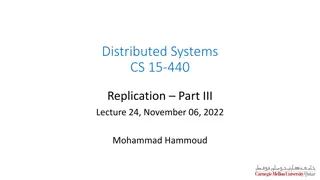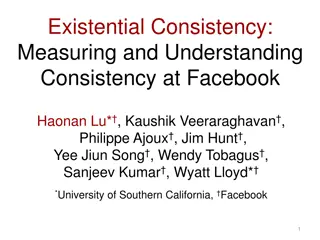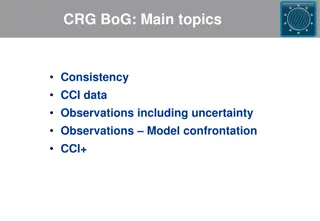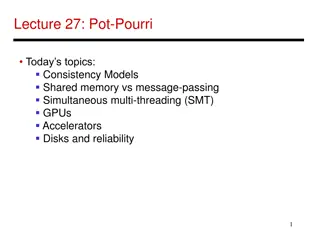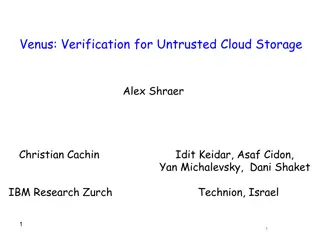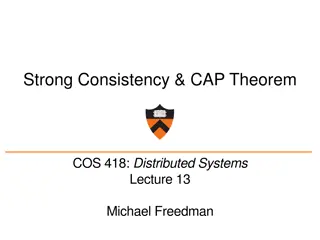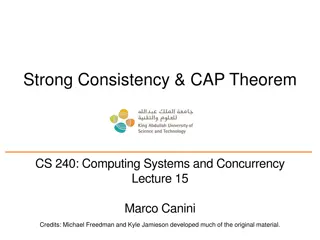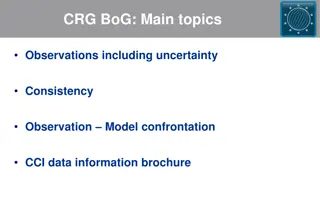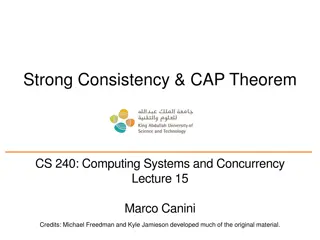
Consistency Models in Distributed Systems
Explore the concepts of consistency, strict serializability, linearizability, and their examples in distributed systems. Learn about total ordering, real-time ordering, and the pros and cons of different consistency models.
Download Presentation

Please find below an Image/Link to download the presentation.
The content on the website is provided AS IS for your information and personal use only. It may not be sold, licensed, or shared on other websites without obtaining consent from the author. If you encounter any issues during the download, it is possible that the publisher has removed the file from their server.
You are allowed to download the files provided on this website for personal or commercial use, subject to the condition that they are used lawfully. All files are the property of their respective owners.
The content on the website is provided AS IS for your information and personal use only. It may not be sold, licensed, or shared on other websites without obtaining consent from the author.
E N D
Presentation Transcript
Consistency Nov 10, 2022
Consistency Models Strict Serializability Sequential Eventual Stronger Weaker Linearizability Causal+
Consistency Models Strict Serializability Sequential Eventual Stronger Weaker Linearizability Causal+
Strict Serializability Transactions: operations that span multiple objects (e.g., keys in KV store) atomically commit (or abort). Total order: There exists some legal total ordering of transactions. Legal (intuitively defined for strict serializability): in the total ordering, read operations see the latest write operation. Preserves real-time commit order: if txn A commits before txn B begins, then txn A occurs before txn B in the total order. Write ops in a committed txn are visible to all future txns read ops. Intuition: once a read sees a txn and commits, all future reads must also see that txn. Pros: applications can easily reason about correctness of transactions. Cons: strict serializability imposes high read and write latencies on system.
Strict Serializability Example Strictly Serializable? Yes Strictly Serializable? No {W(x)b, W(y)b} {W(x)b, W(y)b} P1: P1: {W(x)a} {W(x)a} P2: P2: P3: {R(x)a} {R(x)b} P3: {R(y)b} {R(x)a} P4: {R(x)b} {R(y)b} P4: {R(x)b} {R(y)b}
Consistency Models Strict Serializability Sequential Eventual Stronger Weaker Linearizability Causal+
Linearizability Total order: There exists some legal total order of operations (not txns). Difference from strict serializability? Single-object operations! No transactions! Preserves real-time ordering: if an operation A completes before operation B begins, then op A occurs before op B in the total order. A completed write op is visible to all future read ops. Intuition: once a read sees a new write, all future reads must also see that write. Pros: Easy to reason about correctness Cons: High read and write latencies
Linearizability Example Linearizable? No Linearizable? Yes P1: W(x)a P1: W(x)a P2: W(x)b P2: W(x)b P3: R(x)b R(x)a P3: R(x)a R(x)b P4: R(x)b R(x)a P4: R(x)a R(x)b
Consistency Models Strict Serializability Sequential Eventual Stronger Weaker Linearizability Causal+
Sequential Consistency Total order: there exists some legal total order of operations. Preserves process ordering: total order respects order of each process s operations. Difference from linearizability? Order of ops across processes not determined by real-time Pros: Can allow more orderings than linearizability better performance. Cons: Many possible sequential executions increased application complexity
Sequential Consistency Example Sequentially Consistent? Yes Sequentially Consistent? No P1: W(x)a P1: W(x)a P2: W(x)b P2: W(x)b P3: R(x)b R(x)a P3: R(x)b R(x)a P4: R(x)b R(x)a P4: R(x)a R(x)b
Consistency Models Strict Serializability Sequential Eventual Stronger Weaker Linearizability Causal+
Causal+ Consistency Partial order: order causally related ops the same way across all processes +: replicas total order eventually converge. Difference from sequential consistency? Only causally related ops need to be ordered: no guaranteed total order. Concurrent ops may be ordered differently across different processes. Pros: preserves causality while improving efficiency. Cons: harder to reason about concurrency.
Ops Concurrent P1 P2 No a,b a Yes a,e e No a,g b Yes c,e No c,d f c No d,g No d,f g e,g No d a,d No
Causal+ Consistency Example Causally+ Consistent? Yes Causally+ Consistent? No P1: W(x)a P1: W(x)a P2: W(x)b P2: R(x)a W(x)b P3: R(x)b R(x)a P3: R(x)b R(x)a P4: R(x)a P4: R(x)a
Consistency Models Strict Serializability Sequential Eventual Stronger Weaker Linearizability Causal
Eventual Consistency Eventual convergence: If no more writes, all replicas eventually agree. Difference from causal consistency? Does not preserve causal relationships Is the + in causal+. Frequently used with application conflict resolution, anti-entropy Pros: highly available; think Bayou. Cons: no safety guarantees, need conflict resolution
In a nutshell... Strict Serializability: total order + real time guarantees over transactions Linearizability: total order + real time guarantees over operations Sequential consistency: total order + process order Causal+ consistency: causally ordered + replicas eventually converge Eventual consistency: tventually, everyone should agree on state
Exercise 1: Consistency Model: Strictly Serializable Yes Linearizable Yes P1: {W(x) 1, W(y) 2} {R(y) 4} Sequential Yes Causal+ Yes P2: {W(x) 1, R(y) 4} Eventual Yes {W(x) 0, W(y) 4} P3: P4: {R(x) 0} {R(x) 1}
Exercise 2: Consistency Model: Linearizable Yes Sequential Yes Causal+ Yes P1: W(x) 1 R(y) 4 Eventual Yes P2: R(x) 1 R(y) 4 R(x) 1 W(y) 4 P3: P4: R(x) 1 R(y) 4
Exercise 3: Consistency Model: Linearizable No Sequential Yes P1: W(x) 3 W(y) 7 Causal+ Yes P2: W(x) 1 Eventual Yes R(x) 1 R(x) 3 P3: R(y) 7 R(x) 1 R(x) 3 R(y) 7 P4: R(x) 1 R(x) 3 P5: R(y) 7
Exercise 4: Consistency Model: Linearizable No Sequential No P1: W(x) 3 W(y) 7 Causal+ Yes P2: W(x) 1 Eventual Yes R(x) 1 R(x) 3 P3: R(y) 7 R(x) 3 R(x) 1 R(y) 7 P4: R(x) 1 R(x) 3 P5: R(y) 7
Exercise 5: Consistency Model: Linearizable No Sequential No Causal+ Yes P1: W(x) 1 Eventual Yes P2: W(x) 3 P3: W(x) 7 R(x) 3 R(x) 7 R(x) 1 P4: R(x) 1 R(x) 7 P5: R(x) 3
Exercise 6: Consistency Model: Linearizable No Sequential No Causal+ Yes P1: W(x) 1 Eventual Yes P2: W(x) 3 P3: R(x) 3 W(x) 7 R(x) 3 R(x) 7 R(x) 1 P4: R(x) 1 R(x) 7 P5: R(x) 3
Exercise 7: Consistency Model: Linearizable No Sequential No Causal+ No P1: W(x) 1 Eventual Yes P2: R(x) 1 W(x) 3 P3: R(x) 3 W(x) 7 R(x) 3 R(x) 7 R(x) 1 P4: R(x) 1 R(x) 7 P5: R(x) 3


